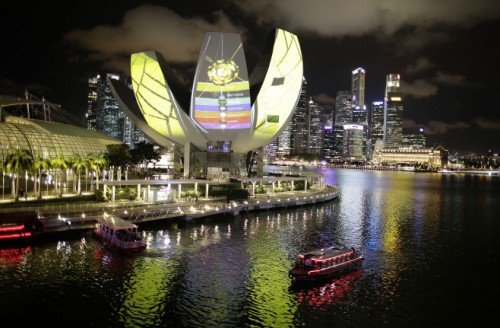 A goat dealer watches his mobile phone in a slum in Jakarta, Indonesia, on Sept. 29, 2015./ Source: AP, Yonhap News A goat dealer watches his mobile phone in a slum in Jakarta, Indonesia, on Sept. 29, 2015./ Source: AP, Yonhap News |
By AsiaToday reporter Jina Koh – Asia's emerging countries are facing slum challenge and opportunity due to rapid urbanization.
 Marina Bay Sands in Singapore, on Mar. 1./ Source: AP, Yonhap News Marina Bay Sands in Singapore, on Mar. 1./ Source: AP, Yonhap News |
For instance, Singapore has succeeded in transforming itself into a modern international city from small town. This small country, whose population is projected to reach nearly 7 million by 2030, has become one of the most advanced countries in Asia with the success of government-led policies. The government has implemented several policies based on technology, and now it is recognized as one of the world's smartest cities in terms of technology-sensing infrastructure, along with New York and London.
Policies to encourage more investment in the major metropolitan areas are essential to build hospitals, schools, highways and other core elements that are needed for cities. This can lead to population diversification, and this is what China has been trying to do with its Jingjinji coordinated development project since 2014.
The Chinese government is focusing on shifting much of Beijing's capital function by taking Jingjinji coordinated development plan as its national strategy. The Jingjinji, or Jing-Jin-Ji (an abbreviation of the Chinese names of Beijing, Tianjin, and Hebei) plan aims to develop these regions into mega cities to reduce the gap with neighboring cities.
According to a recent report by People's Daily Online, the zoo wholesale market in Beijing has more than 30,000 employees and 10,000 daily customers. The area is heavily congested, however many businesses are moving to Hebei as part of the Jingjinji plan. While Beijing and Tianjin are suffering from big city disease, small cities in Hebei are not. If successful, it is expected to solve serious big city problems to certain extent, such as overpopulation and traffic congestion. In 2030, a 3,400-km intercity railway is expected to be built to form a 30-minute commuting circle among the three regions.
Social recognition of slum dwellers should be changed as well. The perspective that slum dwellers are a burden for the government and the society should be dismissed. "In fact, they are the backbones of the economy," said Watanabe.
Most Read
-
1
-
2
-
3
-
4
-
5
-
6
-
7





















